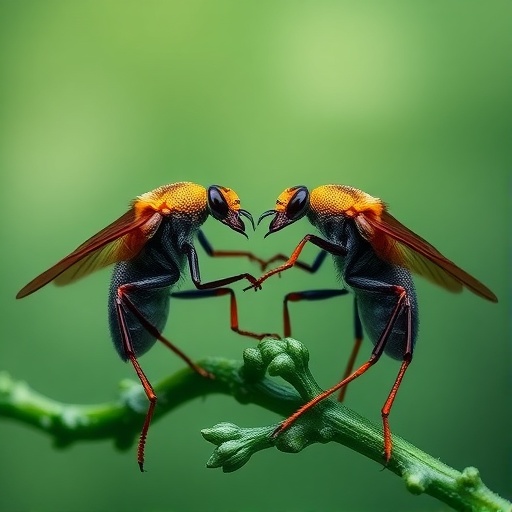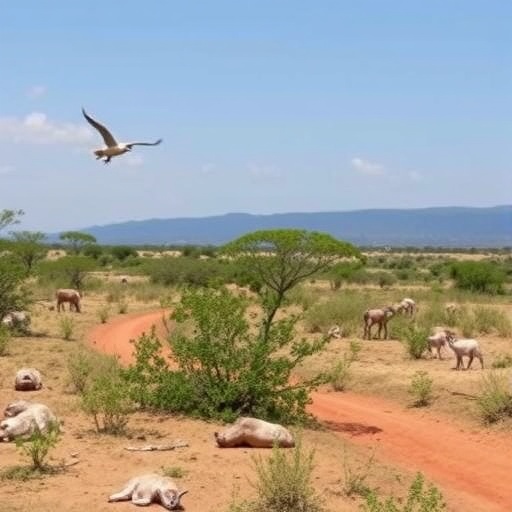
In an intriguing advancement in entomological research, scientists have unveiled critical insights into the chemosensory systems of one of the world’s most notorious blood-feeding insects, the kissing bug, specifically focusing on the species Triatoma infestans. This pivotal study, led by a team of researchers including M. Volonté, L. Traverso, and I. Sierra, and published in BMC Genomics, delves deep into the mechanisms that underpin odorant binding and chemosensory proteins, offering a comparative analysis among various Heteroptera species.
The research emphasizes the importance of understanding the sensory biology of insects, particularly those that play a role in disease transmission, such as T. infestans. This insect is infamous for being a vector for Chagas disease, which poses significant health risks in many parts of the world, particularly in Latin America. Through their investigation, the authors have aimed to illuminate the evolutionary adaptations of chemosensory proteins that enable these bugs to detect and interact with their environments, thus facilitating their survival and reproduction.
Chemosensory proteins (CSPs) play vital roles in the olfactory systems of insects, and T. infestans is no exception. The researchers identified various families of odorant binding proteins (OBPs) that are crucial for olfaction. OBPs transport odorant molecules from the external environment across the lipid membranes of sensory neurons, a preliminary step necessary for olfactory signal transduction. As the team meticulously analyzed genetic sequences, they highlighted both conserved and unique features of these proteins that set T. infestans apart from other Heteroptera species.
One significant finding from the comparative analysis pointed to the expansion of certain CSP and OBP gene families within T. infestans. Such expansions may correlate with the insect’s dietary preferences, particularly its adaptation to blood feeding. By employing bioinformatics tools, the researchers constructed phylogenetic trees that provide a visual representation of the evolutionary relationships between the chemosensory proteins from T. infestans and those from other, functionally distinct Heteroptera. This methodology afforded them detailed insights into genetic divergence, prompting hypotheses about the ecological pressures that have shaped these adaptations.
As the researchers delved further into the functional implications of these proteins, they examined specific genes that exhibited pronounced expression levels in the insect’s antennae, the principal organs of olfaction. By isolating these genes, they were able to propose potential links between the molecular structures of CSPs and behavioral responses to various odorants, such as those emanating from potential hosts. The implications of these findings extend beyond basic science; they bear potential applications in vector management and public health strategies aimed at controlling Chagas disease transmission.
Moreover, the study brings to light the broader implications of olfactory research in insects, particularly in understanding species interactions, foraging behavior, and mating rituals. Understanding the chemosensory landscape can illuminate how these insects navigate their environments, find hosts, and select mates based on olfactory cues. For instance, female kissing bugs may emit specific pheromones that attract males, while both sexes rely on environmental odors to locate food sources.
By comparing T. infestans with other species within Heteroptera, the researchers sought to paint a comprehensive picture of evolutionary adaptations concerning chemosensory capabilities. They posited that these adaptations are not merely a consequence of evolutionary pressure but are also indicative of an intricate relationship between insects and their environments. This work opens the door for future studies that could explore how environmental changes, such as habitat destruction and climate change, might further shape these olfactory systems.
Importantly, the identification of specific odorant binding proteins also holds promise for developing new strategies in monitoring and controlling kissing bug populations. By targeting the chemosensory pathways that these insects use to find hosts, researchers could devise more effective repellents or traps, disrupting their ability to locate people or animals for feeding. This could significantly reduce the incidence of Chagas disease in affected regions and improve public health outcomes.
Furthermore, the authors underscore the potential for this research to inform the development of genetically modified organisms as a means of reducing disease transmission. As gene-editing technologies advance, there is increasing interest in leveraging insights from studies such as this to create modified insects that are less capable of transmitting pathogens. However, such approaches would need to be carefully considered and monitored to avoid unintended ecological consequences.
This comprehensive study serves as a reminder of the intricate biological mechanisms that underpin insect behavior and the profound impact that understanding these mechanisms can have on public health and biodiversity conservation. By elucidating the characteristics of chemosensory proteins in kissing bugs, Volonté and colleagues have provided a valuable foundation for future research in both fundamental entomology and applied sciences.
In conclusion, the research presented in this study is a critical contribution to our understanding of a key insect family that affects millions of people worldwide. The findings not only shed light on the evolution of chemosensory systems in kissing bugs but also pave the way for future innovations in disease prevention strategies. As the world continues to grapple with vector-borne diseases, such research could prove invaluable in changing the landscape of public health.
The comparative analysis conducted by the research team is a testament to the importance of interdisciplinary approaches in science. The integration of molecular biology, bioinformatics, and ecology has allowed for a multifaceted exploration of the chemosensory systems within Triatoma infestans. As we look towards the future, it is clear that understanding the biological underpinnings of insect behavior will be crucial in addressing emerging public health challenges associated with insect-borne diseases.
As the conversation surrounding vector control continues to evolve, studies like these provide critical insights that bridge the gap between academic research and real-world application. The intricate world of insect olfaction hints at a much larger narrative involving co-evolution, host-parasite interactions, and the complexities of ecological dynamics. Engaging with this narrative will be pivotal as we strive to develop holistic strategies for managing the threats posed by vectors such as the kissing bug.
Subject of Research: Chemosensory systems in Triatoma infestans
Article Title: Characterization of odorant binding and chemosensory protein families in the kissing bug Triatoma infestans: comparative analysis among Heteroptera species.
Article References:
Volonté, M., Traverso, L., Sierra, I. et al. Characterization of odorant binding and chemosensory protein families in the kissing bug Triatoma infestans: comparative analysis among Heteroptera species..
BMC Genomics 26, 794 (2025). https://doi.org/10.1186/s12864-025-11967-2
Image Credits: AI Generated
DOI: 10.1186/s12864-025-11967-2
Keywords: chemokinesis, olfactory proteins, vector-borne diseases, Triatoma infestans, public health, chemosensory systems, evolutionary biology, ecological dynamics, gene expression, insect behavior, pheromone signaling, gene editing, molecular biology, biodiversity conservation.
Tags: Chagas disease vectorschemosensory systems in insectscomparative analysis of chemosensory proteinsdisease transmission by kissing bugsentomological advancementsevolutionary adaptations of insectsimportance of CSPs in insectsinsect sensory biologykissing bugs researchodorant binding proteins in T. infestansolfactory mechanisms in HeteropteraTriatoma infestans odorant proteins




